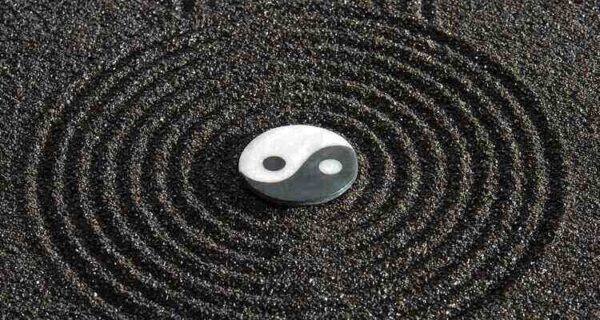There’s much more to it than Pinterest art or Instagram captions. To truly understand the Yin-Yang story, we must take a trip back in time, for it all began in China thousands of years ago. At its core, this theory focuses on the duality in our universe. For each element (or energy) that exists, there is another radically opposite element counterbalancing it. Simply put, it takes two to tango. We’re diving into finer details of the Yin-Yang theory with practicing astrologer Kreena. She’s here to offer her insights into the complex ideas surrounding this ancient Chinese philosophy. Let’s dive right into the model of opposites and enrich our understanding of the world.
Yin and Yang Story – How It All Started
What does Yin and Yang mean, you ask? While pinpointing the exact year of origin is not possible with a concept this ancient, scholars widely believe that we can trace the (written) roots of the Yin-Yang theory to the 10th or 9th century BCE. This theory is associated and understood along with divination, Taoism, Confucianism, and the idea of the Five Phases/Elements. Chinese literature plays a key role in our existing knowledge about Yin and Yang. One of the earliest texts which makes mention of the Yin-Yang story is the I Ching (the Book of Changes), which belongs to the Western Zhou Dynasty. This is a divination manual that focuses on astronomy. An invaluable written record, the I Ching was authored by King Wen. Besides the I Ching, the Shih Ching penned by Confucius is another surviving work that sheds light on the principles of Yin and Yang. He wrote, “Yin and Yang, male and female, strong and weak, rigid and tender, heaven and earth, light and darkness, thunder and lightning, cold and warmth, good and evil… The interplay of opposite principles constitutes the universe.” On the other hand, the Daoist philosophical work Tao Te Ching by Laozi mentions Yin and Yang in Chapter 42. He calls the Yin-Yang theory ‘The Way’; an undeniable truth that governs the cosmos. But we travel further back in time to the 3rd century BCE. Cosmologist and alchemist Zou Yan believed that life went through Five Phases or wuxing – metal, wood, water, fire, and earth.But this process was guided by the ultimate principles of Yin and Yang. Though no documentary evidence is available from this era, it is known that Zou Yan’s school was named Yin Yang Jia making him one of the earliest adherents of this theory.
The Yin and Yang symbol
The popular Yin and Yang symbol is a beautiful representation of this philosophy. The circle is divided into two parts, one black and one white, with each part bearing a dot of the opposite color. Hence, two different halves make a whole; forever connected, counterbalancing, and carrying a little bit of each other. They cannot be separated into distinct compartments because they are intertwined for eternity. This symbol can be found in Chinese history around 600 BCE where it started as an astronomical device used to measure shadows. It is also representative of the winter (Yin) and summer (Yang) solstices. While it is no longer used for a scientific purpose, philosophy and religion hold the Yin and Yang symbol in supreme regard. Truly remarkable, isn’t it? The ancients did us good by passing down this priceless knowledge. And now that we’ve done a quick historical recap of the Yin-Yang story, let’s proceed to grasp its meaning. We’ll understand the two together, as well as individually. So, what does Yin and Yang mean?!
What Does Yin And Yang Mean?
All things are relative in this world of ours. We appreciate candy because kale sets the bar quite low. But we also recognize that kale is better for our health because candy causes cavities. The Yin-Yang theory says that for every candy you have kale – both are integral to each other. The cosmos is made up of infinite dualities that keep the seesaw in balance. But this does not mean that these opposites are pitted against each other. These pairs might be contradictory in nature, but in reality, they are complementary. The two components of a duality belong to the cosmic energies of Yin and Yang respectively. Visualize the Yin and Yang symbol as you read on about opposites attracting each other.
What does Yin and Yang mean? The two cosmic energies explained
The meaning of Yin: The black half of the symbol, Yin stands for the feminine. It is linked with darkness, inward energy, winter solstices, the moon, negativity, stillness, water, etc. The Yin sustains all life and is passive in natureThe meaning of Yang: The white half of the symbol, Yang stands for the masculine. Yang is associated with light, outward energy, summer solstices, the sun, positivity, activity, fire, etc. It is also the driving force behind creativity
Hold your horses and cease to think of Yin as the bad and Yang as the good. But isn’t Yin supposed to be the bad guy? What does Yin mean? It’s a little more complex than that. Because a very important facet of the Yin-Yang story is that they both derive meaning from each other. Consequently, Yin and Yang are inseparable. One energy can be predominant at a point in time but an excessive imbalance is a precursor of disaster. Naturally, people strive to achieve equilibrium between the two. In fact, the philosophy is found in many areas ranging from astrology to medicine. Even individuals have Yin and Yang within them and so do their equations with others. Most harmonious relationships manage to strike the balance – they are excellent examples of the Yin-Yang theory. This is exactly what we’re taking up next. What does Yin and Yang mean in a relationship?
What Is Yin And Yang In A Relationship?
Kreena explains, “Put very simply, Yin and Yang in relationships means that opposites attract. We all have a certain set of qualities or traits; no one is perfect and there are bound to be deficits in a few areas. Hence, we are attracted to people who possess the strengths we don’t. We seek partners who complement us and our missing pieces. Psychologically speaking, people are curious about those who are different from them. They are drawn to others who are a contrasting personality very naturally.” Take a moment and think of a power couple you know. Do they share the same interests? Are their approaches similar? Probably not. They are quite different when you observe them closely, and yet, they go together very well. Like chili chocolate. For instance, the most successful marriage I’ve seen is that of my aunt. She’s a reclusive, artsy person while her husband is a big talker with a scientific turn of mind. On a purely factual basis, they have nothing in common. But look closer and you’ll see why their 35-year marriage is still going strong. Do you now grasp what does Yin and Yang mean?
The ultimate partnership – Yin and Yang in relationship
Kreena says, “Suppose you’re starting a business and your area of expertise is finance and accounting. You’re scouting for a partner who can invest, as well as take over a certain part of daily operations. Do you join hands with someone who is into finance? Or is your preference someone with a different forte like management, public relations, human resources, etc.? A relationship is also a partnership. There is a mutual attraction between opposites because they’re stronger together.” Yin and Yang in relationships mean a complete union; the ultimate fulfillment in love. Most TV and film representations suggest the same – Ross and Rachel, Jake and Amy, Alexis and Ted, Monica and Chandler, Dwight and Angela, Penny and Leonard, Jack and Rose, and the list is endless. But let’s clarify something right away by explaining what differences mean. ‘Opposites attract’ is not a ticket to dating ‘bad boys/girls’. Kreena puts it best, “You can’t have different value systems and peg it on the Yin-Yang theory. Differences lie in approaches toward life. Maybe he likes climbing the corporate ladder while you believe in freelancing as a free soul. Or maybe he likes keeping things private but you share quite easily with people. Despite these points of contrast, there is some common ground – a shared vision, or similar moral compasses.” There is a circle that ties the two halves together in the Yin and Yang symbol after all. And it has been long-established that balance is required for a fruitful existence. What does Yin and Yang mean in terms of finding the balance? And why is it so hard?
How To Find The Balance Between Yin And Yang
Dan Brown wrote, “The ancients envisioned their world in two halves – masculine and feminine. Their gods and goddesses worked to keep a balance of power. Yin and Yang. When the male and the female were balanced, there was harmony in the world. When they were unbalanced, there was chaos.” Well, I certainly don’t want any chaos in your relationships.
Yin and Yang in relationship with self
The first step toward finding balance is looking inward. You can’t find equilibrium in your relationship unless there’s equilibrium within. What is your core? Yin or Yang? Knowing the predominant energy can help you by leaps and bounds. Kreena says, “There are two ways to go about this, Tarot and astrology. The former is a good choice for a short-term reading. It can tell your energies for 6 months to a year. The latter is wiser to know your core. Astrology can tell you what is the underlying and permanent energy within.” Once you understand yourself better, you will lead a more mindful life. A surplus of either energy is inadvisable. What does Yin mean in its excess? Too much of Yin can lead to pessimism, laziness, and solitude. Being receptive is a great quality but too much passivity never did anyone good. And what about Yang? Too much of Yang is the gateway to disappointment through unrealistic optimism or blind passion. There’s a thin line between taking control of your life and having control issues. Inculcating both Yin and Yang, and regulating the dominant one is crucial for growth.
What does Yin and Yang mean with regard to one’s partner?
Each relationship sees a situation of tug-of-war. Your partner’s ways are contrary to yours – if they like confrontation, you’re one for letting things go – learn how to compromise between these two extremes. If person A has a core inclination toward action and person B uses a ‘watch-from-afar’ policy, they can take five steps forward from their respective positions and adopt a ‘wait-and-watch-before-reacting’ tactic. Both partners have much to learn from each other. They can pick up each other’s habits of the opposite energy. A boyfriend with a dominant Yin can learn to hope for the good things and a girlfriend with a dominant Yang can become more accepting of the challenges life throws at her. This way, both will become more balanced – without and within. I hope I’ve answered your questions about what does Yin and Yang mean. You have my very best wishes on your journey of finding equilibrium between the two. May you embody the Yin-Yang story every step of the way!


